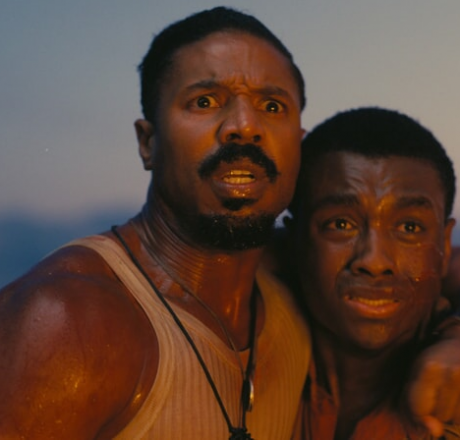Arts
You are here
The blues versus the vampires

May 11, 2025
Review of Sinners, directed by Ryan Coogler
The new movie Sinners, directed by Ryan Coogler, is an exultant, excessive, horror-and joy-filled picture that reminds us of the sheer pleasure that movie-going can bring. Coogler is a young director whose films, even when they take place in fantastic worlds like Black Panther, are always grounded in the reality of what it means to be Black in America.
His first film, Fruitvale Station, was an arresting and impressive debut which marked his first collaboration with actor Michael B Jordan. Fruitvale Station, although not a documentary, was based on the events leading to the death of Oscar Grant, a young man killed in 2009 by Bay Area Rapid Transit (BART) police officers in Oakland, California.
Vampires
Sinners has a foot in the fantastic world of vampires but is also very much grounded in the real history of Black oppression and the pervasive racism of the Jim Crow South. It begins with a young Black man, Sammie, (new actor Miles Caton) bursting into his father’s church mid-sermon, bloodied and holding a jagged broken-off guitar neck clutched in one hand.
The movie then takes us to the previous day to explain the events that lead to Sammie’s distraught appearance at church. It all begins with the return of long absent twin brothers Elijah and Elias Moore, called Smoke and Stack, both played by Michael B Jordan. Smoke and Stack are returning to Clarksdale, Mississippi in 1932 from big city Chicago and murky dealings with the mob.
They have money and a plan. They buy an old shack from a somewhat jovial but menacing white man who refers to them repeatedly as ‘boys’. Their dream is to turn the shack into a juke joint for playing the blues. The grand opening of Club Juke is to happen that very night. Along the way they add a whole cast of helpers, including Smoke’s former lover, Annie (Wunmi Mosaku), a hoodoo healer. (Hoodoo is a set of beliefs and practices from West Africa brought to North America and the Caribbean through the slave trade, and linked to the African religion of voodoo.) Smoke claims not to believe in anything he can’t see but will change his tune by the end of the night.
Sammie is their cousin, and they enlist him to play at the grand opening, given his virtuosity on the slide guitar and as a blues singer. Sammie’s father, a minister, implores him not to go, warning, “You keep dealing with the Devil, one day he’s gonna follow you home.”
Along the way they also pick up an old blues musician, (embodied with great humour by the superb Delroy Lindo) who they find playing harmonica for coins at the train station.
Coogler’s movie foregrounds the rich ethnic reality of the time with the appearance of Choctaw Indigenous horse riders who try to warn a poor white family against the evil that’s coming, in the form of a charming but mysterious Irish visitor named Remmick (Jack O’Connell), as well as a couple of Chinese descent, Bo (Yao) and Grace (Li Jun Li), who run a grocery and are recruited to help cook for the grand opening.
Racism
The presence of the Klan and Jim Crow racism is a theme that runs throughout the movie, in a glimpse of the white Klan robes in the poor whites’ cabin, in the stories that Delta Slim tells about white people who ‘love’ the blues but just don’t like the people who play them, or in comments such as Smoke’s retort to Sammie, who asks what it’s like to live in Chicago where ‘Black men are free to go where they like’. Smoke sets him straight, ‘Chicago ain’t shit but Mississippi with tall buildings instead of plantations.”
But the title of the movie, Sinners, doesn’t refer to people who drink, dance and listen to music, as Sammie’s reverend father seems to imply. In fact, Coogler’s move is a pean to the power of Black music in all its forms, both historical and present. In an incredible collective scene, of which there are many, the entire dance floor comes alive with people dancing to the blues being played on stage, but interspersed with people playing ancient African rhythms, as well as hip hop and rap artists.
When the three vampires make their appearance at the club (the Irishman and the two whites he claims as his first victims) things begin to shift, as they entice or waylay stragglers who wander outside the club, since they need to be invited in, as vampire lore would have it.
When Stack’s ex-girlfriend, Mary (Hailee Steinfield), who is herself a woman passing as white with a mixed-race history, becomes a victim of the vampires she in turn attacks Stack. At this point the movie becomes a battle royale between the club goers and the vampires. Although the three interlopers appear friendly it’s clear they want to steal the souls of the Blacks at Club Juke.
There are many great set-pieces in Sinners, one of them being the sight of the now much larger group of vampires dancing to Irish traditional music in a kind of stomping frenzy. Sinners is a great film about the meaning of community and the many barriers that Black Americans faced and continue to face in order to get out from under the yoke of white oppression.
Twins
It’s worth pointing out the symbiosis between director Coogler and his regular leading man, Michael B Jordan. Jordan is remarkable in this film, playing identical twin brothers, whose personalities are well delineated, in spite of the fact they’re being played by the same actor. Stack is the more devilish, reckless of the two. Smoke is more somber and haunted by the memory of a child that he and Annie lost a long time ago, a theme which will return at the end of the movie.
But Jordan’s character Smoke will appear in many guises in the movie, not least as a Black avenging angel with a twist, exacting a terrible but just revenge against the white man who claimed at the beginning of the movie that ‘the Klan don’t exist no more.’
Jordan is remarkable in the leading role, but the whole cast acts as a real ensemble, befitting one of the important themes of Coogler’s film, survival as a community in a sometimes hostile world. They live and breathe and laugh and love and it all happens in one night at Club Juke.
This is one movie where you’ll want to stay for the credits and the incredible epilogue that travels 60 years to the 1990s and speaks to the important connections between past and present and the roots of Blues music in the history of Black survival.
Section:
Topics:










